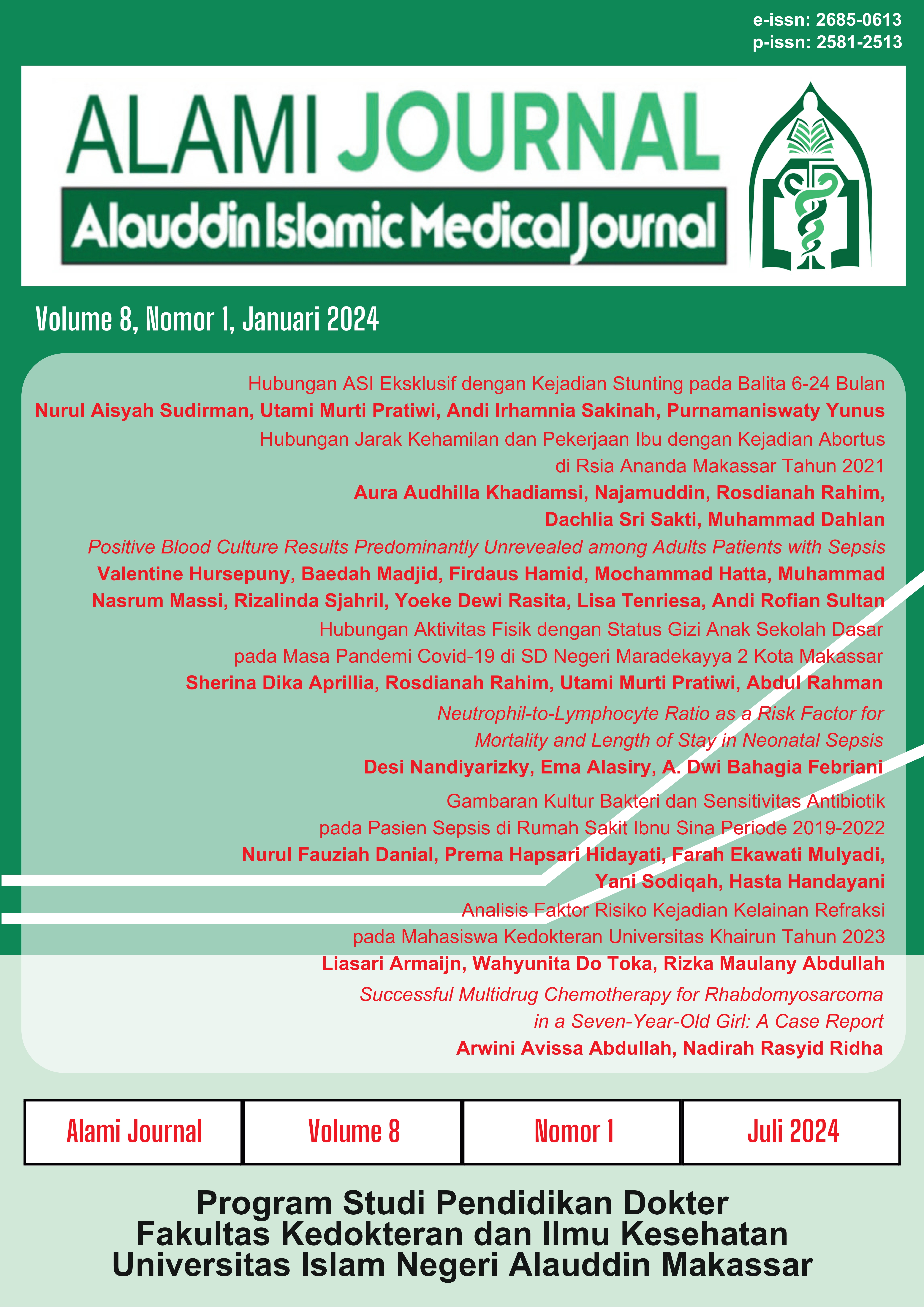Bacteriological Profile and Antibiotic Sensitivity of Sepsis Patients at Ibnu Sina Hospital (2019-2020)
Abstract
Sepsis is a life-threatening organ dysfunction caused by an imbalance in the host's response to infection. This study aims to determine the description of bacterial culture and antibiotic sensitivity in sepsis patients at Ibnu Sina Hospital for the 2019-2022 period taken from medical record data. This study used a descriptive observational design with a retrospective approach based on secondary data from medical records at Ibnu Sina Hospital for the 2019-2022 period. Of the total 111 sepsis patients at Ibnu Sina Hospital for the 2019-2022 period, 89 samples were found with positive cultures and the most common bacteria found was Alkaligenes faecalis bacteria in 21 samples (23.6%) followed by Klebsiella sp. as many as 19 samples (21.3%) and Klebsiella pneumoniae as many as 12 samples (13.5%). The most sensitive antibiotics are levofloxacin and amikacin. It can be concluded that nosocomial infections with the most bacteria cause sepsis patients at Ibnu Sina Hospital are Alkaligenes faecalis (23.6%) and Klebsiella sp. (21.3%) which are gram-negative aerobic bacteria.
References
Evans L, Rhodes A, Alhazzani W, et al. Surviving Sepsis Campaign: International Guidelines for Management of Sepsis and Septic Shock 2021. Crit Care Med. 2021;49(11).
Purwanto DS, Astrawinata DAW. Mekanisme Kompleks Sepsis dan Syok Septik. Jurnal Biomedik (JBM). 2018;10(3):143-51.
Irvan I, Febyan F, Suparto S. Sepsis dan Tata Laksana Berdasar Guideline Terbaru. Jurnal Anestesiologi Indonesia. 2018;10(1):62-73.
Rudd KE, Johnson SC, Agesa KM, et al. Global, regional, and national sepsis incidence and mortality, 1990–2017: analysis for the Global Burden of Disease Study. The Lancet. 2020;395(10219):200-11.
Cavaillon J, Singer M, Skirecki T. Sepsis therapies: learning from 30 years of failure of translational research to propose new leads. EMBO Molecular Medicine. 2020;12(4).
B G, Salam SH, Hisbullah H, Arif SK, Rum M, Palinrungi AS. The Association of Cumulative Fluid Balance and Sepsis Patient Mortality During Treatment in the Intensive Care Unit. Nusantara Medical Science Journal. 2022;7(2):88-97.
Ginting F, Barimbing ML, Ginting NM. Antimicrobial resistance local data in sepsis. International Journal of Infectious Diseases. 2019;79:53.
Mahapatra S, Heffner AC. Septic Shock (Sepsis). Finlandia: StatPearls Publishing; 2020.
Wijaksana DS, Anggraeni N, Endriani R. Pola Bakteri dan Resistensi Antibiotik pada Pasien Sepsis di Intensive Care Unit (ICU) RSUD Arifin Achmad Provinsi Riau Periode 1 Januari – 31 Desember 2017. Jurnal Ilmu Kedokteran. 2019;13(2):46-54.
Astutik AW, Annisa N, Rusli R, Ibrahim A. Kajian kesesuaian pemilihan antibiotik empiris pada pasien sepsis di instalasi rawat inap RSUD Abdul Wahab Sjahranie Samarinda. 5th Mulawarman Pharmaceuticals Conference Proceedings 2017. 2017(5):38-47
Niederman MS, Baron RM, Bouadma L, et al. Initial antimicrobial management of sepsis. Critical Care. 2021;25(307):1-11.
Singer M, Deutschman CS, Seymour C, et al. The third international consensus definitions for sepsis and septic shock (sepsis-3). JAMA - Journal of the American Medical Association. 2016;315(8):801-10.
Salsabilah N, Wahyuni A, Sidharti LS. Faktor-Faktor yang Berpengaruh Terhadap Kejadian Ventilator Associated Pneumonia. Medical Profession Journal of Lampung. 2023;13(3):259-64
Dharmayanti IGA, Sukrama DM. Karakteristik bakteri Pseudomonas aeruginosa dan pola kepekaannya terhadap antibiotik di Intensive Care Unit(ICU) RSUP Sanglah November 2014-Januari 2015. Jurnal medika. 2019;8(4):1-9.
Indah Lestari P, Susanti I, Rahmawati H. Pola Kepekaan Bakteri terhadap Antibiotik di Ruang Rawat Intensif RSPI Prof. Dr. Sulianti Saroso Jakarta. The Indonesian Journal of Infectious Diseases. 2013;1(2):23-7.
Aisenberg G, Rolston K V., Safdar A. Bacteremia caused by Achromobacter and Alcaligenes species in 46 patients with cancer (1989-2003). Cancer. 2004;101(9):2134-40.
Hasan MJ, Nizhu LN, Rabbani R. Bloodstream infection with pandrug-resistant Alcaligenes faecalis treated with double-dose of tigecycline. IDCases. 2019;18:1-3.
Ardiani T, Yusriani Mangerangi K, Ekawati Mulyadi F, Sommeng F, Irmandha SK. Literature Review Uji Sensitivitas Antibiotik Terhadap Bakteri Penyebab Penyakit Sepsis. Fakumi Medical Journal : Jurnal Mahasiswa Kedokteran. 2020;2(4):251-9.
Izadi E, Afshan G, Patel RP, et al. Levofloxacin: Insights into antibiotic resistance and product quality. Frontiers in Pharmacology. 2019;10(881):1-7.
Werida RH, El-Okaby AM, El-Khodary NM. Correction to: Evaluation of levofloxacin utilization in intensive care units of tertiary care hospital: a retrospective observational study. Drugs & Therapy Perspectives. 2020;36: 33-9.
Copyright (c) 2024 Prema Hapsari Hidayati, Nurul Fauziah Danial, Farah Ekawati Mulyadi, Yani Sodiqah, Hasta Handayani

This work is licensed under a Creative Commons Attribution-NonCommercial-ShareAlike 4.0 International License.
Once an article was published in the journal, the author(s) are: granted to the journal right licensed under Creative Commons License Attribution that allows others to share the work with an acknowledgement of the work's authorship. permitted to publish their work online in third parties as it can lead wider dissemination of the work. continue to be the copyright owner and allow the journal to publish the article with the CC BY-NC-SA license receiving a DOI (Digital Object Identifier) of the work.


